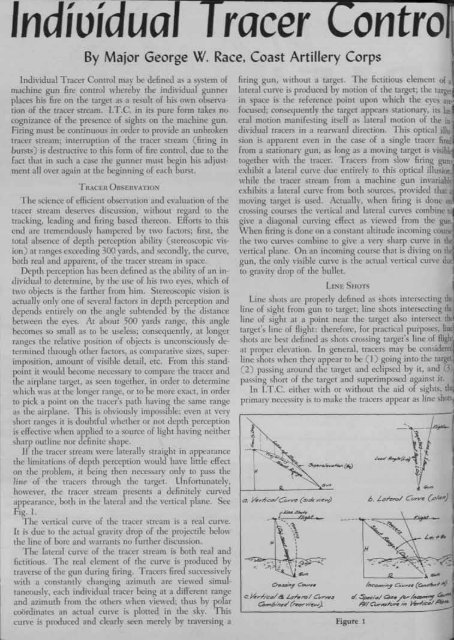July-August - Air Defense Artillery School
July-August - Air Defense Artillery School
July-August - Air Defense Artillery School
Create successful ePaper yourself
Turn your PDF publications into a flip-book with our unique Google optimized e-Paper software.
Individual racer ontro<br />
By Major George W. Race, Coast <strong>Artillery</strong> Corps<br />
Individual Tracer Control mav be defined as a svstem of<br />
machine gun fire control wher~by the individuaf gunnel<br />
places his fire on the target as a result of his own observation<br />
of the tr:tcer stream. l.T.C. in its pure form takes no<br />
cognizance of the presence of sights on the machine gun.<br />
Firing must be continuous in order to pro\'ide an unbroken<br />
tracer stream; interruption of the tracer stream (firing in<br />
bursts) is destructive to this fom1 of fire control, due to the<br />
fact that in such a case the gunner must begin his adjustment<br />
all over again at the beginning of each burst.<br />
TRACER OBSERVATION<br />
The science of efficient observation and e\'aluation of the<br />
tracer stream deserves discussion, without regard to the<br />
tracking, leading and firing based thereon. Efforts to this<br />
end are tremendously hampered by two factors; first, the<br />
total absence of depth perception ability (stereoscopic vision)<br />
at ranges exceeding 300 yards, and secondly, the curve,<br />
both real and apparent, of the tracer stream in space.<br />
Depth perception has been defined as the ability of an individual<br />
to determine, by the use of his two eyes, which of<br />
two objects is the farther from him. Stereoscopic vision is<br />
actually only one of several factors in depth perception and<br />
depends entirely on the angle subtended by the distance<br />
between the eyes. At about 500 yards range, this angle<br />
becomes so small as to be useless; consequently, at longer<br />
ranges the relative position of objects is unconsciously determined<br />
through other factors, as comparative sizes, superimposition,<br />
amount of visible detail, etc. From this standpoint<br />
it would become necessary to compare the tracer and<br />
the airplane target, as seen together, in order to determine<br />
which was at the longer range, or to be more exact, in order<br />
to pick a point on the tracer's path having the same range<br />
as the airplane. This is obviously impossible; even at very<br />
short ranges it is doubtful whether or not depth perception<br />
is effective when applied to a source of light having neither<br />
sharp outline nor definite shape.<br />
J f the tracer stream were laterally straight in appearance<br />
the limitations of depth perception would have little effect<br />
on the problem, it being then necessary only to pass the<br />
line of the tracers through the target. Unfortunately,<br />
however, the tracer stream presents a definitely curved<br />
appearance, both in the lateral and the vertical plane. See<br />
Fig. 1.<br />
The vertical curve of the tracer stream is a real curve.<br />
It is due to the actual gravity drop of the projectile below<br />
the line of bore and warrants no further discussion.<br />
The lateral curve of the tracer stream is both real and<br />
fictitious. The real element of the curve is produced by<br />
traverse of the gun during firing. Tracers fired successively<br />
with a constantly changing azimuth are viewed simultaneously.<br />
each individual tracer being at a different range<br />
and azimuth from the others when viewed; thus by polar<br />
coordinates an actual curve is plotted in the sky. This<br />
curve is produced and clearly seen merely by traversing a<br />
firing gun, without a target. The fictitious element of a<br />
lateral CUf\'eis produced by motion of the target; the targe:<br />
in space is the reference point upon which the eyes ar~<br />
focused: consequently the target nppears stationary, its lal<br />
ernl motion manifesting itself as lateral motion of the in<br />
dividunl trncers in n renrward direction. This optical illu<br />
sion is npparent even in the case of a single tracer fired<br />
from n stationary gun, ns long as a moving target is visibl<br />
together with the tracer. Tracers from slow firing gum.<br />
exhibit a lateral CUf\'e due entirely to this optical illusion<br />
while the tracer stream from a machine gun invariabl<br />
exhibits a lateral curve from both sources, provided that<br />
moving target is used. Actually, when firing is done on<br />
crossing courses the vertical and lateral CUf\'es combine t<br />
give a diagonal curving effect as viewed from the gun<br />
\ Vhen firing is done on a constant altitude incoming course<br />
the two CUf\'es combine to give a very sharp CUf\'e in the<br />
vertical plane. On an incoming course that is diving on th<br />
gun, the only visible curve is the actual vertical cun'c du<br />
to gravity drop of the bullet. I<br />
LINE SHOTS I<br />
Line shots are properly defined as shots intersecting the<br />
line of sight from gun to target; line shots intersecting the<br />
line of sight nt a point near the target also intersect the<br />
target's line of flight: therefore, for practical purposes. line<br />
shots arc best defined as shots crossing target's line of High<br />
at proper elevation. In general, tracers may be considcrt'l!<br />
line shots when they appear to be (l) going into the targe<br />
(2) passing around the target and eclipsed by it, nnd (3 I<br />
passing short of the target and superimposed against it.<br />
In l.T.c. either with or without the aid of sights. the<br />
primary necessity is to make the tracers appear as line sho"l<br />
'.<br />
C. Jk.,.!'ca/ d La,l""",/ C""W3<br />
c;",..6,n,/ (r=r we ..... )<br />
6. Lor~ral Cl/rve (p/an)<br />
~ ",,,,<br />
Int:o-n,;,,y co .....# (c-..n.....#)<br />
d. Sp=ia/ COr./0,./~ '-'"<br />
191/C''''r_rorr ,;" V~i
















